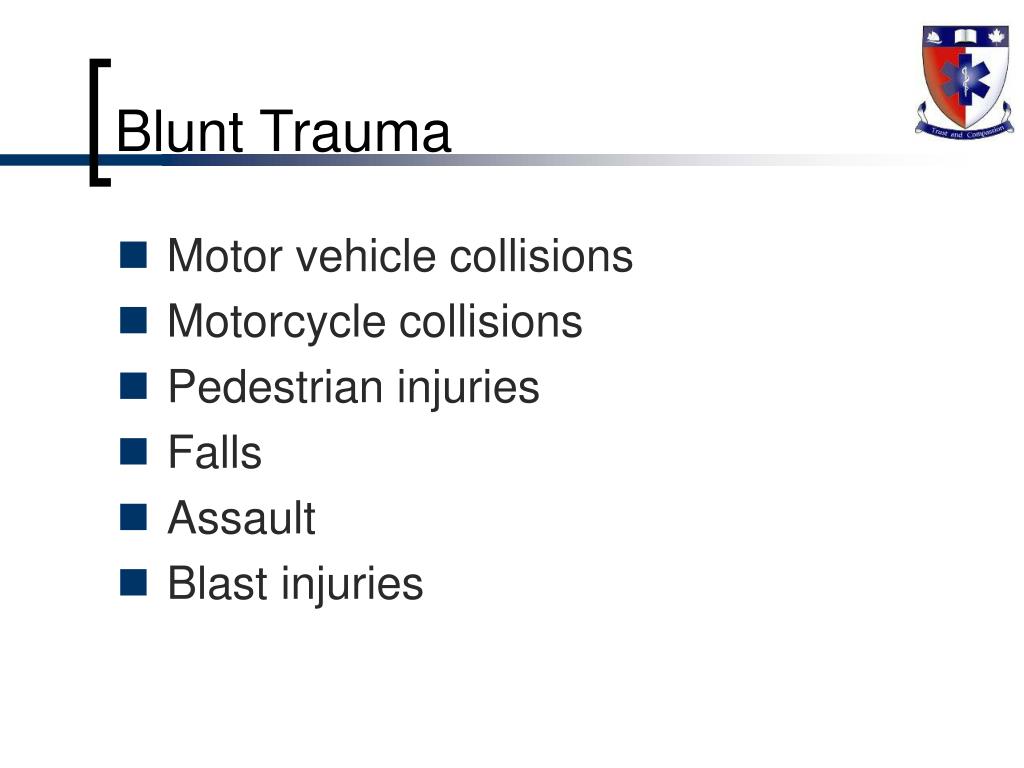
In addition to the medical expenses and personal care that might be necessary to treat the injury, you may also lose substantial income because you are unable to work.Ī personal injury claim against the party who caused your brain injury can result in compensation for your financial damages. If another party is responsible for causing your injury, that person could be held liable for damages and losses caused by the blunt force head trauma. Causes of brain injury caused by blunt force trauma include: Any blow, bump, or jolt to the head can lead to brain injuries. Many situations can cause a blunt force head trauma.

Cognitive therapy can help when learning, judgment, and attention are impaired because of a blunt force head trauma.
#Blunt trauma how to
The person may need to learn how to perform specific tasks again or differently.Ĭounseling may also be necessary to help a person learn to cope with the changes in their life caused by a brain injury. The long-term complications and permanent impairments caused by blunt force head trauma may require physical therapy and occupational therapy. A variety of medications may be prescribed to treat the damage, including: Depending on the type of brain damage and the severity of the damage, surgical intervention may be required. However, some patients may require extensive treatment for a blunt force head trauma. With rest and time, the brain may heal itself. Some cases may require minimal medical intervention. The treatment of a blunt force head trauma depends on the area of the brain that was injured and the severity of the injury. A shunt is sometimes used to reduce the pressure inside the skull.

Swelling from a blow to the head can cause additional injury to the brain. If there appears to be swelling in the brain, the doctor may insert a probe through the skull. MRIs and CT scans of the brain can produce detailed images that assist doctors in diagnosing a brain injury.ĭoctors may also perform a variety of neuropsychological, language, cognition, and speech tests to determine the level and severity of a brain injury. Imaging tests can be used to view the damage to the brain tissue and assess whether there could be bleeding within the brain. The lower the score, the more severe the brain injury. The Glasgow Coma Scale “scores” the patient based on the patient’s ability to function in three key areas.

A physician may begin by evaluating the patient on the Glasgow Coma Scale. Symptoms are one indication that a person sustained a head injury. How Are Blunt Force Head Traumas Diagnosed?ĭoctors perform a variety of tests to diagnose blunt force head traumas. When the blunt force head trauma occurred because of an accident, documentation of the injury is required to win a personal injury case. If you or a family member experiences any symptoms after a head trauma, immediate medical attention may be necessary to prevent further injury or death.

Symptoms may be mild, and some people may assume they merely have a headache or are suffering from the shock and aftermath of an accident. Until a person develops symptoms of a blunt force head trauma, the person may not know an injury occurred. In many closed head injuries, including blunt force head trauma, there may not be any outward signs of injury.īruises may develop, but that could take some time. Unfortunately, brain injuries can be difficult to diagnose, especially blunt force head trauma.Ī person can sustain a traumatic brain injury without realizing they have sustained an injury to the brain. Brain injuries can result in life-altering, permanent disabilities. Brain injuries are some of the most serious injuries a person can sustain in an accident.


 0 kommentar(er)
0 kommentar(er)
